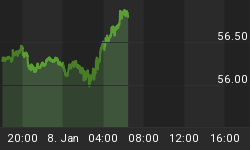The good news is:
• All of the broad based breadth indicators are still movingsharply upward.
Summation indices (SI) are running totals of oscillator values. When the oscillator is positive the SI rises when the oscillator is negative, the SI falls. The chart below shows the NASDAQ composite (OTC) and NASDAQ SI's calculated from advancing issues - declining issues, new highs - new lows and upside volume - downside volume for the past year. The SI's offer a good indicator of the trend and all of the NASDAQ SI's are heading sharply upward.

Last week I pointed out that the OTC had a run of 8 consecutive up days for the first time since December 1999. The implications of that for the next several months are positive, however, the short term implications of that extreme overbought condition are negative.
The chart below shows the OTC along with an indicator that tries to identify a cyclical pattern in the NASDAQ advance - decline line (ADL). The chart covers the past year and I have drawn an arrow identifying last September. There are similarities between last September and the current period. The indicator was at the top of the screen for 2+ weeks going into the third week of September, a pattern similar to what we have now.

The seasonal pattern of late September is similar to early June.
The next chart shows the OTC with an average of every June since 1963 in yellow and an average of every June in just the 1st year of the presidential cycle in white.
Since 1946 the average month has had 21 trading days, but they vary from 19 to 23 trading days. Data for the chart is calculated by taking the first 11 and last 10 trading days of the month. The result is in some years, days in the middle of the month are counted twice and in others they are not counted at all.
On average, the high for the month has occurred on the equivalent of next Tuesday.

The Russell 2000 (R2K) was first formulated in 1987 so we have a little less than 20 years of data for that index. The chart below shows the same averages as the chart above, but calculated from the R2K over its more limited time frame. The chart for the R2K is very similar to the OTC, but exaggerated.

The next chart is similar to the previous two, but calculated from the S&P 500 (SPX) using data from 1928. Prior to 1946 the markets traded six days a week and there were usually 26 trading days in the month. In the chart below there are usually 5 trading days cut out of the middle of every month. The patterns are quite a bit different, but there is still a short term high on the 5th trading day of the month (next Tuesday).

The market appears healthy in every way, but, by nearly every measure, it is as overbought as it has been at any time in the past year. Entering a period of seasonal weakness from an overbought condition suggests next week will be down.
I expect the major indices to be lower on Friday June 10 than they were on Friday June 3.
Last week the large cap indices were down slightly while the small cap indices were up slightly so I am calling my positive forecast a tie.
This report is free to anyone who wants it, so please tell your friends. If it is not for you, reply with REMOVE in the subject line.
If you are lucky enough to be in Minnesota this summer and would like to attend our FastTrack user group meeting on the 1st Wednesday of the month, let me know and I will put you on the meeting notification list.
















